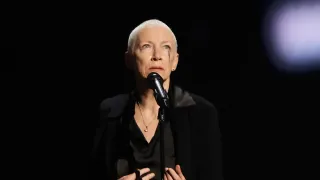June 22, 2014
The 'Next' Big Thing :: 'Pattern of Life'
Michael Cox READ TIME: 10 MIN.
"Can I try something?" asks Lewis D. Wheeler at a rehearsal of New Rep's "Pattern of Life," (running through June 29 at the BU Theatre, Lane-Comley Studio 210.)
"Lewis," says the show's director Bridget Kathleen O'Leary, "you should know by now not to ask me that question." It's a particularly nice spring day, and the Boston University studio where this rehearsal is taking place has a gorgeous view of blue skies over the harbor.
"I don't need to pre-approve your choices," the director continues, gently emphatic. "If it doesn't work I'll let you know."
The new partnership between New Rep and the Boston Center for American Performance (BCAP) at Boston University is a win-win for everyone involved. As the professional production extension of the BU School of Theatre, BCAP welcomes the experience and talent that New Rep brings to collaborate with students, and New Rep is better able to produce and share their inaugural Next Rep Festival, an inspiring, ambitious project where plays are created and developed from the script-level into production.
"Playwrights are the next civil rights movement in the theatre," Bridget tells me. Her eyes are bright and her smile is inviting. People are naturally drawn to this woman, New Rep's Associate Artistic Director, because she genuinely cares about the people around her. A pageboy haircut softly frames her heart-shaped face, and its natural hickory color, bares distinct highlights of blush wine, especially in the sunlight. It's as though her personal lighting designer has a fixation with rose-colored gels.
"There's something really wonderful about being in a rehearsal room with actors and designers. (I love it when designers are present.) And playwrights don't have that. They sit in a room by themselves," the director continues. "Then they just send their plays out and hope for the best. There's no process to that. There's no rehearsal. They're just expected to do it right the first time."
When Bridget came to New Rep in 2008, she started to think about how she could make playwrights a part of the rehearsal method. Then in 2011, Jim Petosa replaced Kate Warner as Artistic Director of the company, and he took Bridget's commitment to fostering a home for playwrights a step further. He made certain that some of the plays in Bridget's "Next Voices Playwriting Fellowship Program" moved all the way to a full production.
"Pattern of Life" is the final of four fully-staged shows (and three public readings) that New Rep has produced this year in an intimate black box setting, all part of a festival that actively explores the "next" iteration of dramatic works.
"The National New Play Network has a program called the Smith Prize," "Pattern of Life" playwright Walt McGough told me in an interview last January. "Essentially you put together a proposal for a commission -- it has to be a political play. I wrote the proposal. Submitted it. And the proposal got me so excited that I just wrote the whole play."
In a series of dueling soliloquies, "Patter of Life" tells the story of two men thousands of miles apart, a drone pilot in Nevada and the Pakistani villager who is a victim of the solder's mistake.
"But NNPN passed on my proposal," continued Walt.
Because New Rep is a part of the NNPN, Bridget had seen the proposal and wondered where Walt had taken his idea. She told him this when she ran into him one day at "a poetry reading or something like that," said Walt.
Bridget, who reads at least one new play every day, said, "send me the script if you have it," and she added it to her pile.
"It was in a very, very rough shape," Walt informed me, "but she, in turn, passed it to Jim, and they offered me a production."
Since early last September, Bridget has met with Walt and three other "Playwriting Fellows" with the specific goal of actively developing work for theatrical production. Along with this show, Danny Bryck, Deidre Girard and Evan Sanderson have all had rehearsed and staged readings of their works.
At first, the playwrights look at pieces: Scenes, acts or whatever the writer has, and scripts are read aloud by whoever is in the room. "I try not to get actors involved too early in the process," says Bridget. "Actors have a way of hiding the plot holes. That's what they're trained to do. Just act the hell out of a moment, and sometimes that moment doesn't exist."
One of the unique aspects of Bridget's program is that she recognizes the importance of the designer's voice and necessity of letting the playwright hear it.
BU graduate student Courtney Nelson was chosen to be the scenic designer for all the shows in the "Next Rep Festival," and her concept for "Pattern of Life" is mesmerizingly subtle yet marvelously dramatic in its own right.
Staged in the round, there are four essential set pieces, a table and two chairs in the center of the space, and a bench set off in a corner, among the audience. But the most visually dominant element of the set is a series of analogue television boxes, piled on top of one another and placed in various conspicuous areas. On all sides, the audience is boxed into a cage of fencing.
Perfectly square patterns abound in the wire walls and on the floor, even the pixels that reflect the onstage action into the televisions are boxes.
But if you look closely, you see the distortions: The images on the screen are unclear, smashed fragments of fiberglass roofing hang from the walls of our wire cage and the whole structure is coated in thin rust, decomposing the construction.
In January, when I first interviewed Walt, the play hadn't been cast, but Walt said this to me: "I don't write a part for a certain actor. But there are actors and performers who I, sort of, hear in my head while I'm writing, people who I've had really good experiences with. Like Nael Nacer, who came into my play 'The Farm' and totally redefined the character he was playing."
Nael has become somewhat famous in the Boston theatre community for his ability to embody "the other," the ennui and the longing of the desperate outsider. Like James Dean and Montgomery Clift, this "other" character is one we both relate to and misunderstand.
It was no surprise when Nael showed up at the first staged reading of "Pattern of Life" in February. I heard excited whispers in the house, "Look. They were able to get him."
Though it took place at BU, there was a full crowd for that reading, and this is one of the incredible things about New Rep audiences. Days in advance, I have clamored to try and reserve free tickets to a reading in the "Next Rep" series. A reading.
You expect to see theatre people at a reading, but not season subscribers. Patrons of New Rep recognize themselves as a vital and creative force in the realization of live theatre, and they don't shy away from their responsibility.
Throughout this entire festival, one of the most exciting contributors has been the New Rep audience. These people defy the New England stereotype by walking right up to me after performances and talking. "I know I don't know you from Adam," they seem to say, "but we just shared something together, as a group, and I want to talk about this with you."
This would be unusual if it happened after one show, but this has happened to me after every show in the festival.
After the reading of "Pattern of Life," we all chipped in our ideas about the show, but as often happens at these events, one person would offer an opinion and another person would contradict it.
How do Walt and Bridget wade through all these viewpoints? I wondered. With all the disputing ideas, how are plays ever finished?
Then Jim Petosa piped in and cut to the chase. He asked Walt a few simple questions that addressed and summarized all of our scattered opinions.
The play features two characters from different cultures that never meet, but individually address the audience, and separately tell their stories.
Jim prepared Walt for his next draft by asking him a few simple questions. Among these were, "Who are these characters talking to? And what do they want to get from their audience?"
This brings us back to the rehearsal at BU, one week before the opening of the show.
Lewis, looking like an all-American boy (if all Americans are tall and handsome with broad shoulders and bulging biceps, standing perfectly poised even in repose) and feeling free to try new things, makes a remarkable decision and accomplishes the impossible.
During a two-page monologue where he talks to the audience about the man that he imagines Nael's character to be, he suddenly stops and turns away. Then he walks right up to Nael and points to him directly. The fourth wall was broken when the action of the play started, now Lewis has broken another wall, a wall of time and space.
Bridget doesn't stop the actor, though some would say he's going too far. After all, this kind of interaction could never really happen. In life, these two men are in completely different countries and they have never met. Then again, not long ago we would never imagine that a person could pilot a plane in Pakistan from a behind a desk in Nevada.
"That was thrilling," Bridget says to me. "In these moments, [the characters] realize the way they impact each other and their stories really start to come alive. It's like Jim keeps saying, 'This play seems like two one-person shows, but it's really a duet.'"
"Now these two are singing," she adds, "and the more comfortable my actors are with the play, the more moments like this they are going to find. Can you imagine doing this alone in front of a computer? God help us if the rest of us had to do it alone. This is why we have rehearsal."
"Pattern of Life"
At the Boston University Theatre
Lane-Comley Studio 210
through June 29






